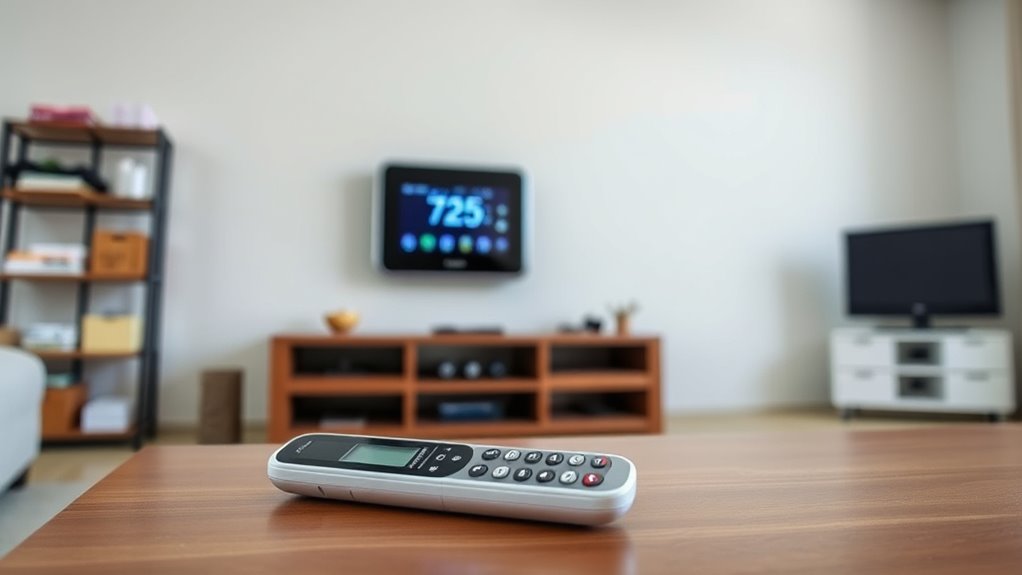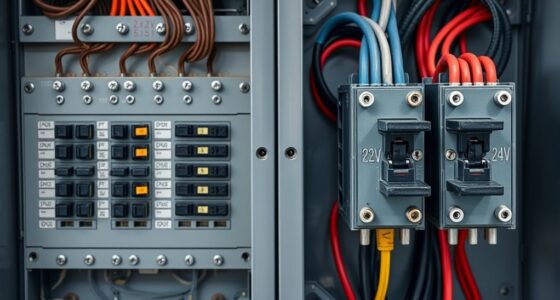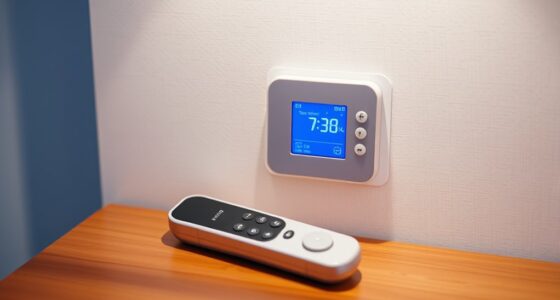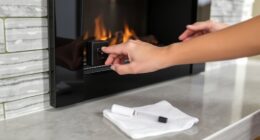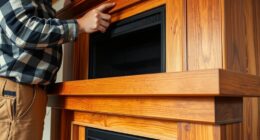To avoid common thermostat and remote mistakes, guarantee proper placement away from drafts, sunlight, and heat sources. Remember to adjust settings seasonally, using programmable features to maintain comfort and save energy. Regularly calibrate devices, replace batteries, and clean sensors to keep them accurate and responsive. Don’t overuse hold functions and rely on automation instead. Check compatibility and keep firmware updated. Staying on top of maintenance and settings will optimize your system’s efficiency and security—more tips follow.
Key Takeaways
- Properly place thermostats away from drafts, sunlight, and heat sources to ensure accurate readings and efficient operation.
- Regularly calibrate and update thermostat settings seasonally to optimize energy savings and comfort.
- Use programmable features wisely, avoiding excessive manual overrides and overuse of the hold function.
- Maintain devices by cleaning sensors, replacing batteries, and installing firmware updates to prevent malfunctions.
- Verify device compatibility and secure remote controls to enhance system security and seamless automation.
Ignoring Proper Placement of Thermostats
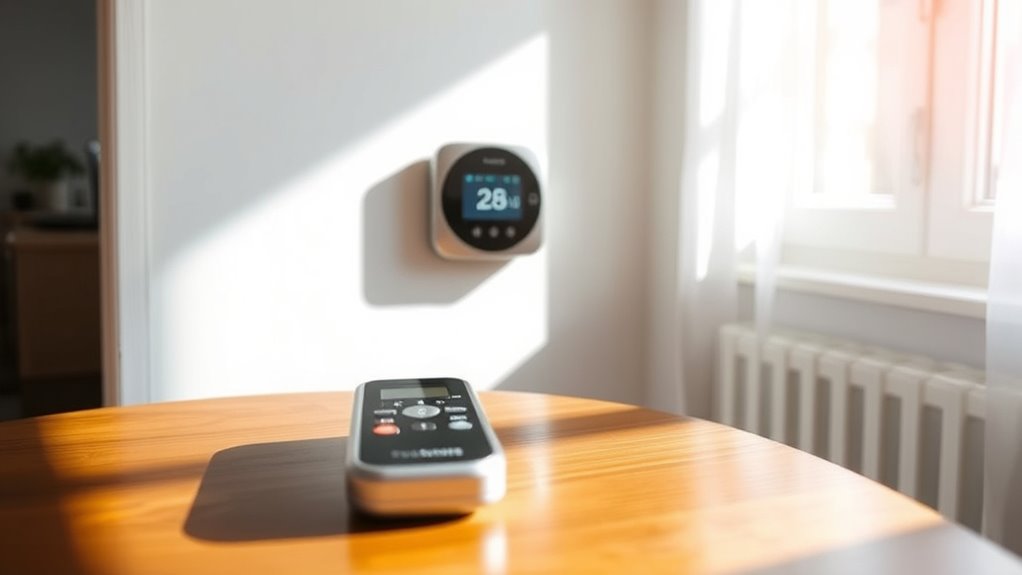
Ignoring proper placement of thermostats can substantially impact your heating and cooling efficiency. Placement issues often lead to inaccurate readings, causing your system to cycle unnecessarily or struggle to reach desired temperatures. Environmental considerations, like drafts, direct sunlight, or nearby heat sources, can skew thermostat readings, making the system work harder than needed. If your thermostat is placed near windows or vents, it may pick up false signals, leading to inconsistent comfort. Avoid mounting it on exterior walls or areas with fluctuating temperatures. Proper placement guarantees your thermostat accurately monitors indoor conditions, optimizing energy use and maintaining comfort without wasting resources. Additionally, selecting a location with stable environmental conditions helps ensure consistent thermostat performance.
Setting It and Forgetting It: Not Adjusting Seasonally
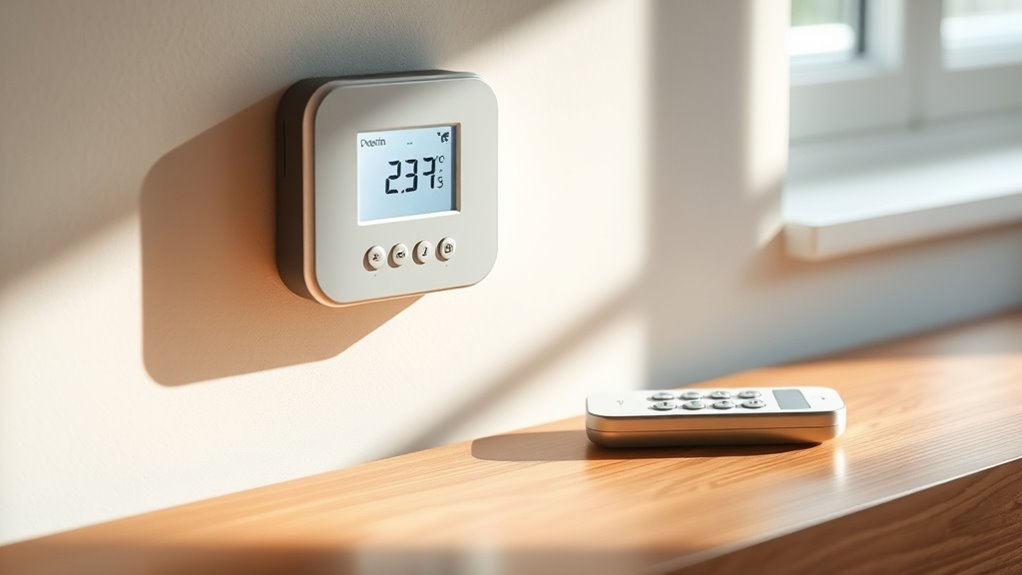
Many homeowners make the mistake of setting their thermostats once and then leaving them unchanged throughout the year. This neglects seasonal adjustments that can improve comfort and efficiency. To avoid this, consider these steps:
- Regularly update your thermostat settings to match the season, lowering temperatures in winter and raising them in summer.
- Perform seasonal adjustments to optimize energy use and comfort.
- Check your thermostat calibration to ensure it accurately reflects the room temperature.
- Use programmable thermostats to automate seasonal adjustments, preventing unnecessary energy waste.
- Understanding the role of thermostat technology can help you select models that automatically adapt to seasonal changes, further enhancing efficiency.
Failing to make these adjustments can lead to increased energy bills and inconsistent comfort. By paying attention to seasonal changes and maintaining proper calibration, you keep your home comfortable year-round and save money.
Using Incorrect Temperature Settings
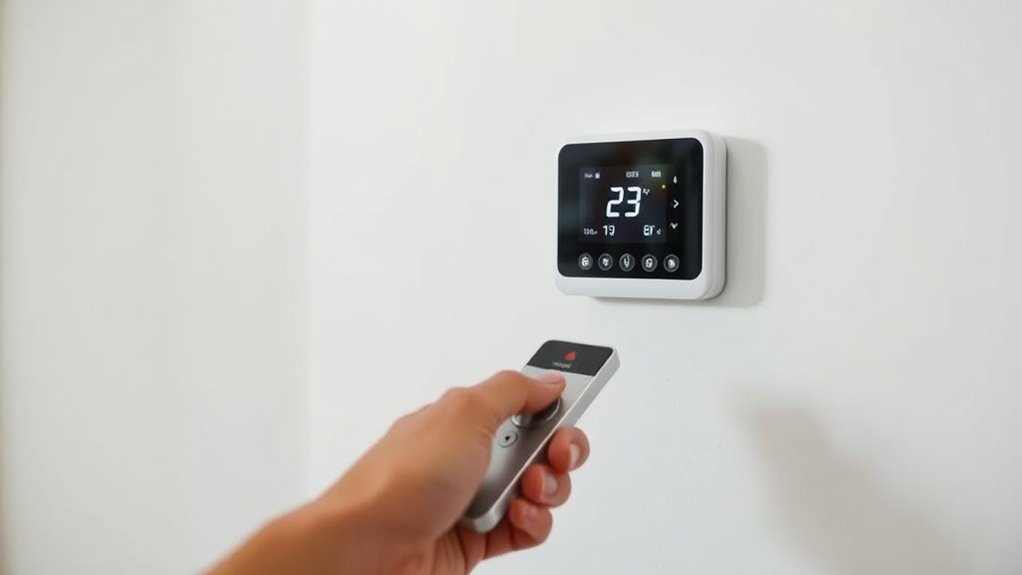
Setting your thermostat too high or too low can waste energy and make your home uncomfortable. Sticking to a proper temperature range helps maintain efficiency and comfort. Avoid frequent adjustments to prevent unnecessary strain on your system. Additionally, utilizing programmable thermostats can optimize temperature settings and enhance overall energy savings.
Proper Temperature Range
Have you ever wondered how using the wrong temperature settings can affect your comfort and energy bills? Setting your thermostat outside the proper temperature range can lead to inconsistent temperature control and higher costs. To avoid this, consider these tips:
- Keep your thermostat between 68-72°F for ideal comfort.
- Regularly check device calibration to ensure accurate temperature readings.
- Maintain temperature consistency by avoiding frequent manual adjustments.
- Use a programmable thermostat to set and stick to a steady temperature schedule.
- Understanding industry trends can help you choose the most efficient devices and settings.
Sticking to the right range and ensuring your device is properly calibrated helps maintain comfort and reduces energy waste. Avoiding improper settings prevents temperature fluctuations and promotes better efficiency.
Avoid Frequent Adjustments
Frequent adjustments to your thermostat can disrupt your home’s temperature stability and increase energy consumption. Constantly changing settings forces your HVAC system to work harder, reducing energy efficiency and raising utility bills. To maximize user convenience, set a comfortable temperature and stick with it, rather than making frequent changes. Using incorrect temperature settings often leads to unnecessary cycling, which wears out your system faster. Instead, choose a consistent temperature that suits your daily routine and seasonal needs. Consider programming your thermostat to automatically adjust throughout the day, maintaining comfort while optimizing energy use. Avoid the temptation to tweak settings constantly; this habit hampers your system’s efficiency and can cause discomfort. Implementing self-awareness about your thermostat habits can help identify patterns of unnecessary adjustments and promote better energy management. Consistency is key to balancing energy savings and user convenience.
Overusing the Hold Function
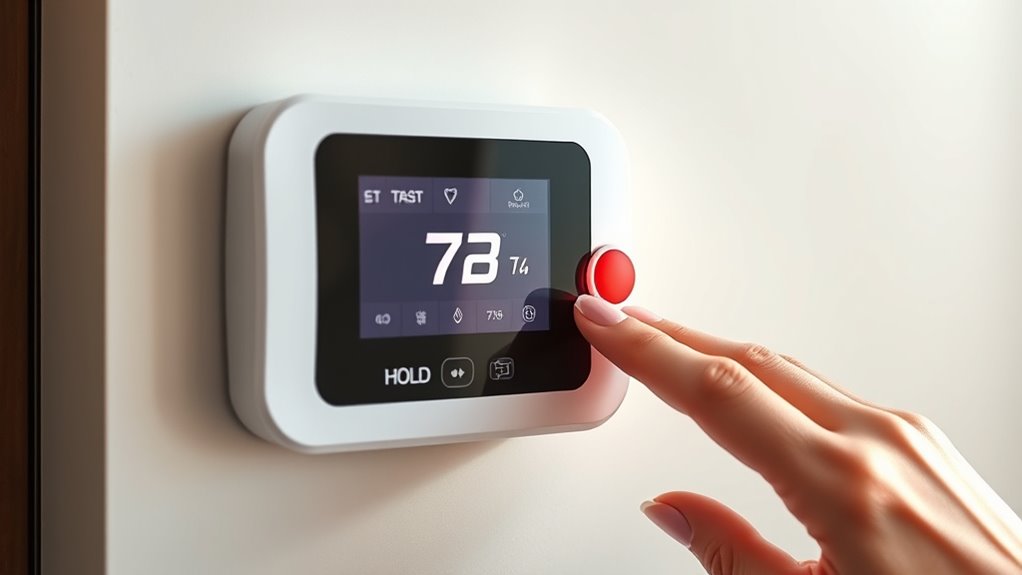
While using the hold function on your thermostat might seem like a quick fix to maintain a comfortable temperature, overusing it can lead to energy waste and higher utility bills. Relying too much on the hold function causes hold function misuse and increases manual override reliance, which can prevent your system from running efficiently. To avoid this, consider these tips:
Overusing the hold function wastes energy and raises utility bills—use it wisely to keep your system efficient.
- Use the schedule feature instead of holding for long periods.
- Limit manual overrides to necessary adjustments only.
- Set your thermostat to eco-friendly modes when possible.
- Regularly review your settings to prevent unnecessary hold activations.
Overusing the hold function disrupts your system’s natural efficiency, leading to unnecessary energy consumption and costs. Be mindful of when and how often you use the hold button to maximize savings.
Not Calibrating or Replacing Batteries Timely
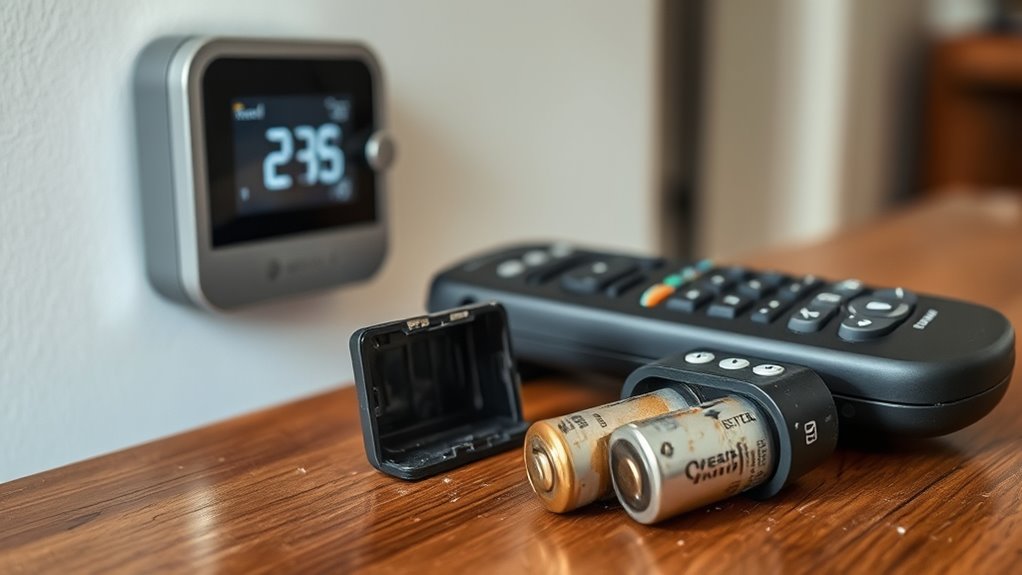
Neglecting to calibrate or replace batteries in your thermostat can cause inaccurate temperature readings and unreliable system operation. Regular battery replacement ensures your device stays powered and functions correctly. When replacing batteries, use fresh, high-quality ones to prevent sudden shutdowns. Calibration techniques, such as adjusting the thermostat settings or using built-in calibration options, help maintain accuracy. Ignoring these steps can result in your heating or cooling system running inefficiently or not responding properly to temperature changes. Keep an eye on battery indicators and replace batteries promptly, especially in extreme weather. Proper calibration and timely battery replacement maintain comfort and system reliability, saving you money and avoiding unexpected breakdowns. Staying aware of device malfunctions and performing regular maintenance can extend the lifespan of your thermostat and ensure optimal performance. Stay proactive to ensure your thermostat performs at its best year-round.
Neglecting to Use Programmable Features Effectively

Many homeowners overlook the value of programmable features on their thermostats. By understanding your options, setting consistent schedules, and adjusting for seasonal changes, you can save energy and stay comfortable. Skipping these steps means missing out on potential efficiency and savings. Additionally, utilizing automation technology in thermostats can further optimize energy use and improve overall home management.
Understand Programming Options
Understanding the programming options available on your thermostat can considerably improve your comfort and energy savings. Many devices have varying degrees of programming complexity, so it’s essential to familiarize yourself with their features. Additionally, consider how the remote control design influences ease of use. To make the most of these features, keep in mind:
- Explore different programming modes to find what suits your schedule.
- Use clear labels on your remote for quick adjustments.
- Set temperature changes that align with your daily routines.
- Avoid overcomplicating schedules to prevent confusion and errors.
- Remember that retail hours for related services can impact your ability to get assistance or updates on device features.
Set Consistent Schedules
Setting consistent schedules for your thermostat helps guarantee your home stays comfortable while saving energy. Use the programmable features to establish regular temperature calibration times that match your routine, avoiding unnecessary heating or cooling when you’re away or asleep. This prevents energy waste and maintains a steady comfort level. Be sure to secure your remote device with strong passwords and enable security features to prevent unauthorized access. Proper scheduling also reduces the risk of accidental adjustments that could disrupt your desired climate. By setting and sticking to a consistent schedule, you maximize your thermostat’s efficiency and ensure your home remains comfortable without constant manual adjustments. Effective use of scheduling and remote security helps you get the most out of your thermostat while conserving energy. Additionally, understanding the AI security vulnerabilities involved in remote access can help you implement more robust safety measures.
Adjust for Seasons
Have you overlooked adjusting your thermostat settings for seasonal changes? Neglecting seasonal adjustments can lead to energy waste and discomfort. To optimize your system, consider these steps:
- Use your programmable thermostat’s seasonal modes to switch between summer and winter settings.
- Adjust temperature calibration to ensure accuracy, preventing unnecessary heating or cooling.
- Set lower temperatures during winter nights and higher in summer days for efficiency.
- Remember to update your schedule as seasons change to maintain comfort and save energy.
- Additionally, understanding the importance of seasonal adjustments can help you better tailor your home’s climate control throughout the year.
Properly using these features helps you avoid common mistakes and ensures your thermostat works effectively year-round. Taking the time for these seasonal adjustments can considerably reduce energy bills and improve your home’s comfort.
Forgetting to Update Firmware or Software
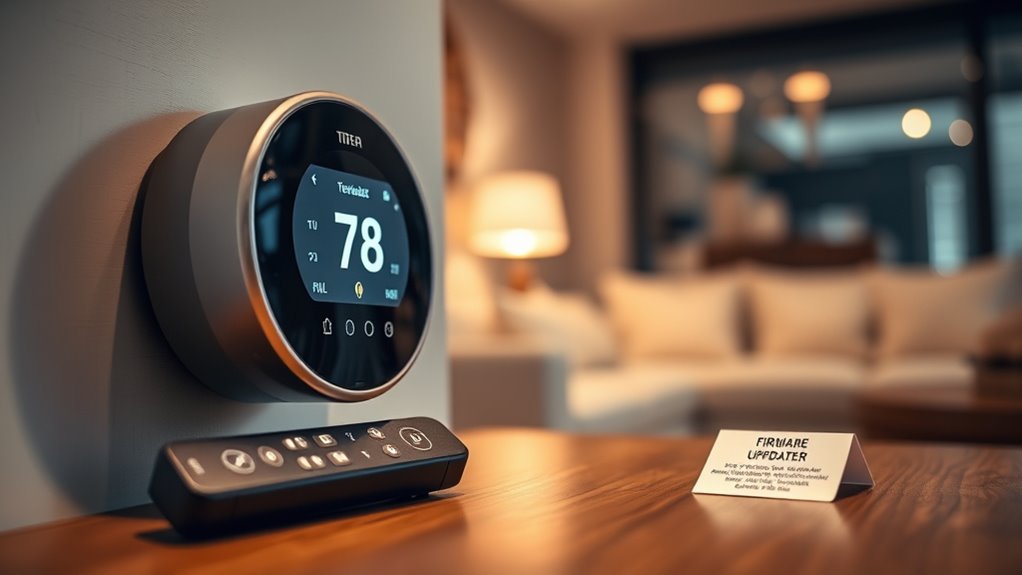
Failing to update your thermostat or remote’s firmware and software can lead to security vulnerabilities, bugs, and missed performance improvements. Firmware updates fix security flaws and enhance device stability, while software upgrades introduce new features and improve functionality. When you neglect these updates, your device may become more susceptible to hacking or malfunctions. Regularly checking for firmware updates and installing the latest software ensures your thermostat and remote operate smoothly and securely. Many manufacturers release updates to optimize energy efficiency or fix bugs that could disrupt comfort control. Don’t overlook this critical step; staying current with updates prolongs device lifespan and guarantees you benefit from the newest security patches and feature enhancements. Make it a habit to review and install updates promptly.
Failing to Secure Your Remote Controls
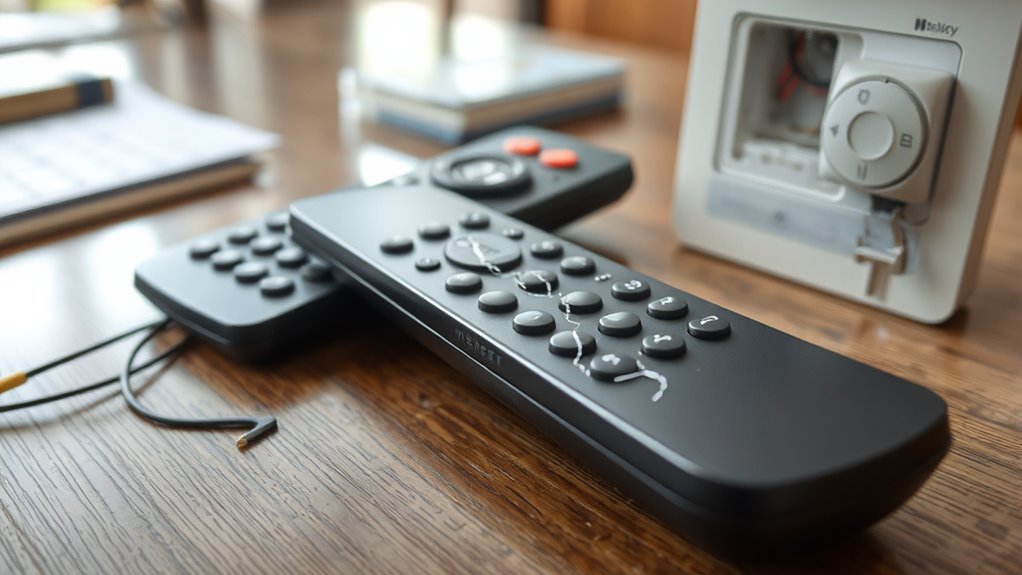
If you don’t safeguard your remote controls, unauthorized users could easily access your systems. Keep remotes out of reach and store them in secure locations to prevent misuse. Limiting access privileges ensures only trusted individuals can operate your devices.
Keep Remotes Out of Reach
Keeping remote controls out of reach is a simple yet essential step in ensuring safety and preventing accidental damage. When you keep remotes away from children, you protect their safety and reduce the risk of remote theft or misuse. To do this effectively, consider these actions:
- Store remotes in high, secure cabinets or shelves.
- Use remote covers to prevent curious children from pressing buttons.
- Establish a designated spot for remotes, making it easy to keep them out of reach.
- Educate family members about the importance of securing remotes and child safety.
Use Secure Storage Solutions
Using secure storage solutions is crucial to prevent remote controls from being misplaced, stolen, or accidentally damaged. By establishing designated spots for your remotes, you enhance remote protection and reduce the risk of loss. Consider using lockable cabinets, wall-mounted holders, or labeled bins to keep remotes organized and accessible only to authorized users. This not only keeps your remote controls safe but also minimizes clutter and confusion. When you prioritize secure storage, you ensure your remotes aren’t left in vulnerable or inconvenient locations. Consistent habits, like returning remotes to their designated spot after use, reinforce remote protection and help maintain control over your devices. Implementing these simple steps saves time, reduces frustration, and keeps your technology secure.
Limit Remote Access Privileges
Failing to limit remote access privileges can expose your devices to unnecessary risks. When you don’t set appropriate privilege limits, unauthorized users might control your thermostats or remotes, leading to potential security breaches. To protect yourself:
- Restrict remote access to trusted devices only.
- Set different privilege levels for users—admin, guest, or limited.
- Regularly review who has remote access and modify privilege limits as needed.
- Enable multi-factor authentication for remote control logins.
Ignoring Energy-Saving Settings and Modes
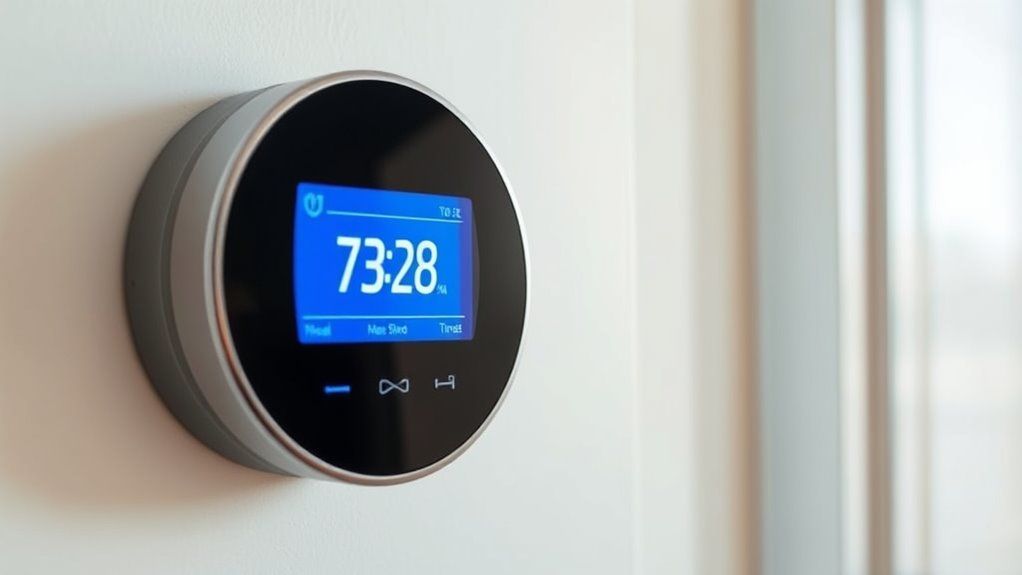
Ignoring energy-saving settings and modes can lead to higher energy consumption and increased utility bills. When you overlook these features, your thermostat or remote isn’t working to optimize energy efficiency, which can cause unnecessary energy waste. Many devices have built-in modes designed to reduce power use during off-peak hours or when rooms are unoccupied, but neglecting to activate or properly configure them defeats this purpose. Additionally, device compatibility plays an indispensable role; if your thermostat or remote isn’t compatible with energy-saving features, you miss out on potential savings. By ignoring these settings, you not only waste energy but also miss opportunities to lower costs and extend device lifespan. Always review and enable energy-saving modes to maximize your device’s efficiency and save money.
Relying on Manual Overrides Excessively
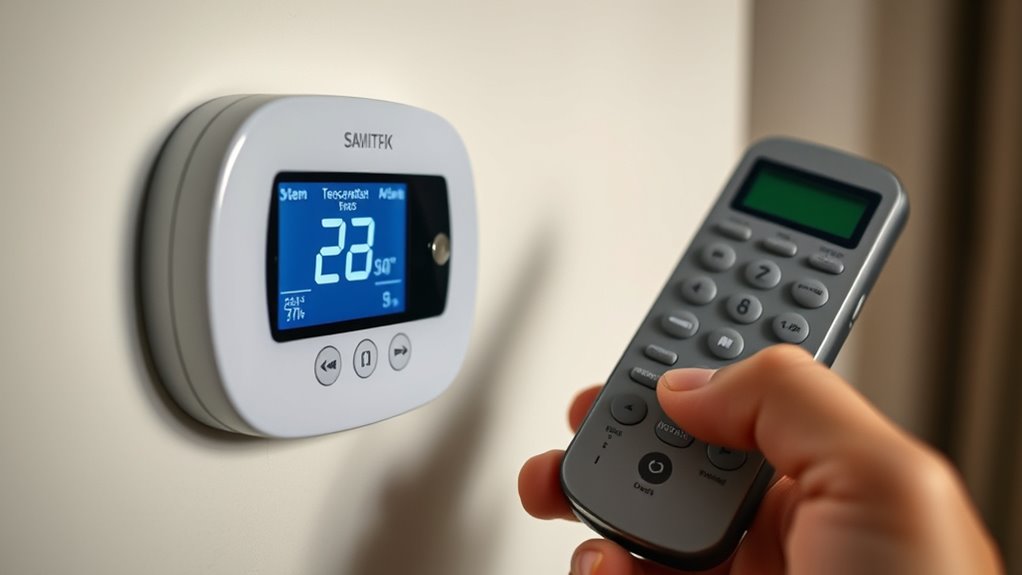
Relying on manual overrides too often can undermine your thermostat’s efficiency and lead to higher energy bills. Manual override pitfalls include disrupting your programmed schedule, causing inconsistent comfort, and increasing energy costs. To avoid these issues:
- Dependence on manual overrides can override your smart settings, reducing savings.
- Frequent manual adjustments may cause your system to work harder, wasting energy.
- Overusing remote control security features might lead to unauthorized access or accidental changes.
- Excessive manual overrides can mask underlying issues with your thermostat or remote, delaying proper maintenance.
Limit manual overrides to ensure your system operates as intended. Proper use preserves energy efficiency and maintains remote control security, preventing unnecessary costs and potential vulnerabilities.
Ignoring Maintenance and Cleaning of Devices
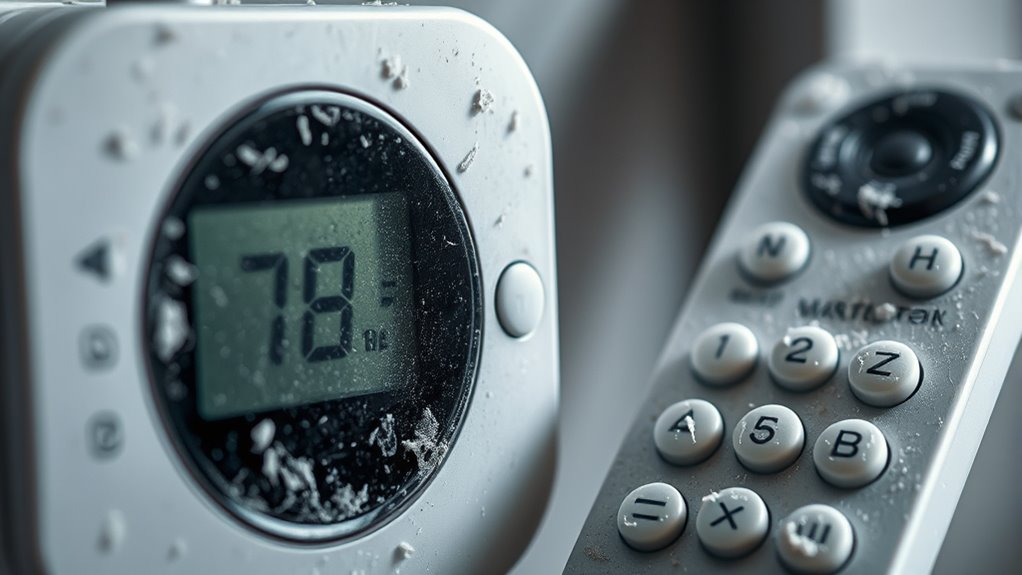
Neglecting regular maintenance and cleaning of your thermostat and remote devices can quickly undermine their performance and reliability. Dirt, dust, and grime build up, reducing device durability and causing unresponsive controls. Proper cleaning extends device lifespan and keeps your system running smoothly. Educate yourself on how to care for your devices to avoid unnecessary repairs or replacements. Here’s a quick guide:
| Maintenance Task | Frequency | Benefits |
|---|---|---|
| Wipe with a soft cloth | Weekly | Prevent dust buildup |
| Replace batteries | Every 6-12 months | Ensures consistent operation |
| Clean vents and sensors | Monthly | Maintains accurate readings |
| Check for firmware updates | As released | Keeps devices up-to-date |
Stay proactive to maximize device durability and ensure seamless control.
Overlooking Compatibility With Smart Home Systems

Failing to verify that your thermostat and remote are compatible with your smart home system can lead to integration issues and limited functionality. Compatibility issues may prevent devices from syncing properly, making automation difficult or impossible. To avoid this, check these key factors:
- Confirm the device’s compatibility with your smart home hub or platform.
- Ensure the remote supports your preferred voice assistants like Alexa or Google Assistant.
- Verify the device’s connectivity options (Wi-Fi, Zigbee, Z-Wave) match your existing system.
- Read reviews or manufacturer specs to identify any known compatibility problems.
Neglecting these steps can hinder smart home integration, forcing you to replace devices later. Taking time upfront guarantees seamless operation and maximizes your investment.
Frequently Asked Questions
How Can I Improve Energy Efficiency With My Thermostat Setup?
You can boost energy efficiency by using smart scheduling to set your thermostat to match your daily routine, avoiding unnecessary heating or cooling when you’re not home. Additionally, guarantee proper temperature calibration to maintain accuracy and prevent energy waste. Regularly review and adjust these settings to optimize comfort and savings, making your system work smarter rather than harder. This proactive approach helps reduce energy consumption and lowers your utility bills effectively.
What Are the Signs My Remote Control Needs Replacement?
If your remote control isn’t working properly, it might need substituting. Look for a flashing or empty battery indicator, which suggests low power. If the buttons are unresponsive or press multiple times without effect, that’s another sign it’s time for a new remote. Over time, wear and tear can cause these issues, so replacing your remote ensures reliable control and better energy efficiency.
How Do I Ensure My Thermostat Is Compatible With Smart Home Devices?
To guarantee your thermostat is compatible with smart home devices, check its wireless protocols like Wi-Fi, Zigbee, or Z-Wave. Make sure it supports compatibility standards your smart home system uses, such as Alexa, Google Assistant, or Apple HomeKit. Verify the thermostat’s specifications and consult the manufacturer’s guidelines. This way, you’ll seamlessly integrate your thermostat with your smart home setup and enjoy smooth, remote control over your climate.
What Are the Best Practices for Maintaining Remote Control Security?
To keep your remote control secure, always enable remote access only when needed and disable it afterward. Use strong, unique passwords for your remote and any associated accounts. Regularly update firmware to patch security vulnerabilities. Avoid sharing login details, and monitor your device’s activity for suspicious actions. These practices help protect your remote control from unauthorized access and assure your smart home remains safe.
How Often Should I Update Firmware for Optimal Device Performance?
Did you know that 80% of device failures are caused by outdated firmware? You should update your firmware at least every three to six months to guarantee ideal device performance. Regular firmware updates improve device compatibility, fix bugs, and enhance security. By staying current, you prevent compatibility issues with new features and protect against vulnerabilities. Don’t wait too long—timely updates keep your thermostat or remote functioning smoothly and securely.
Conclusion
To avoid wasting energy and money, make sure you’re avoiding these common thermostat and remote mistakes. Proper placement, regular calibration, and leveraging energy-saving modes can cut your heating and cooling costs markedly. Did you know that improper thermostat use can increase energy bills by up to 10%? Stay proactive—adjust settings seasonally, maintain your devices, and explore smart home compatibility to maximize efficiency and comfort all year long.
